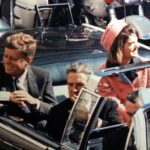By Tim Hayes
It is Friday, Nov. 22.
The presidential motorcade winds through the streets of Dallas, Texas. The president and his wife, riding in the back of an open convertible, wave to throngs of cheering Americans. It is a sunny, beautiful day, and the president seems to be enjoying a growing groundswell of political support. Life is good.
The motorcade turns slowly onto Dealey Plaza for the last leg of the ride to a lunchtime speech by the president, when a series of gunshots pierces the warm Dallas afternoon air. The president has been hit. The limousine races off to Parkland Hospital.
We all know how the story ends. A half-century ago, President John F. Kennedy lost his life in Dallas. On Nov. 22, 1963, the only comprehensive recording of the fatal rifle shots came via the 8mm camera of Abraham Zapruder, the owner of a dressmaking store located near Dealey Plaza.
The “Zapruder film” has been analyzed, disputed, deconstructed, and reconstructed for the past 50 years. And while the official position of the federal government maintains that Kennedy was killed by a lone assassin, the speculation over, and skepticism of, that conclusion has fed a conspiracy theory market that has no signs of letting up or letting go.
But what if that tragic afternoon had happened on Friday, Nov. 22, 2013?
Can you imagine how many recordings of the assassination would be available today? Everyone with a smart phone would have been videotaping his or her view of the president passing by. News crews would have been on the scene, capturing every moment in real time. Even satellite images could have been recalled after the fact.
The world would have seen the murder almost immediately via Twitter, Internet search engines, YouTube, and global news networks. Naturally, the immediacy of information and images available today poses important and difficult pros and cons.
On the plus side, instead of having only a grainy, unsteady strip of 8mm film as the sole source of evidence, investigators could draw from probably hundreds of high-definition recordings from multiple angles to help determine how the crime had been committed. Whether more than a single assassin had killed the president. How the fatal wound had been inflicted. And so much more.
On the minus side, though, the event would have fallen victim to a shortcoming we see all too often in the “race-to-be-first” media landscape of today. Simply having access to information – and reporting it without vetting it properly – does not equate with responsible reporting.
A PBS special in the weeks leading up to the 50th anniversary of the Kennedy assassination detailed the activity at CBS News in New York following the frantic minutes immediately following the shooting in Dallas. Veteran World War II wire service reporter Walter Cronkite, then serving as managing editor of the CBS newsroom, stood as an arbiter of the journalistic standards of affirmation, validation, and confirmation – even as radio correspondents and other networks were much more willing to run with any information or conjecture they could lay their hands on.
In the end, it was Cronkite’s sober announcement – made only after a White House spokesman confirmed the news at Parkland Hospital – that let the world know the president was dead. Compare that with the “wild-west” nature of information dissemination today, and you see that speed for the sake of speed can be astoundingly irresponsible.
The world will never run out of people willing to cause mayhem and murder, unfortunately. Seeing the tragic results of their handiwork may be easier and more widespread today, but that doesn’t let us off the hook in being responsible about how that information gets shared.
Copyright 2013 Tim Hayes Consulting

